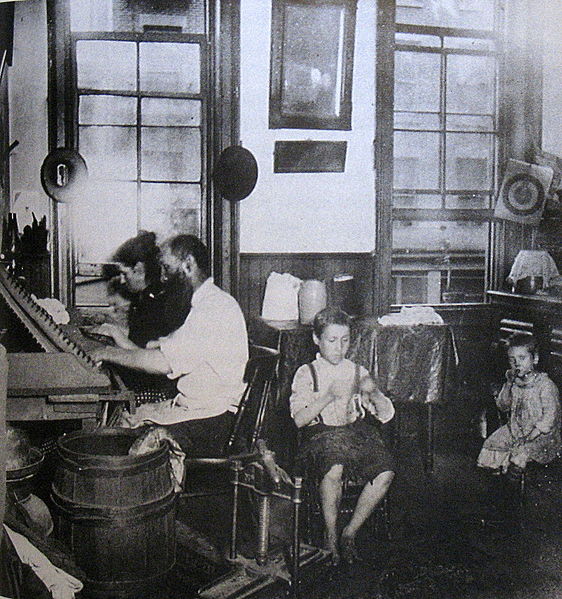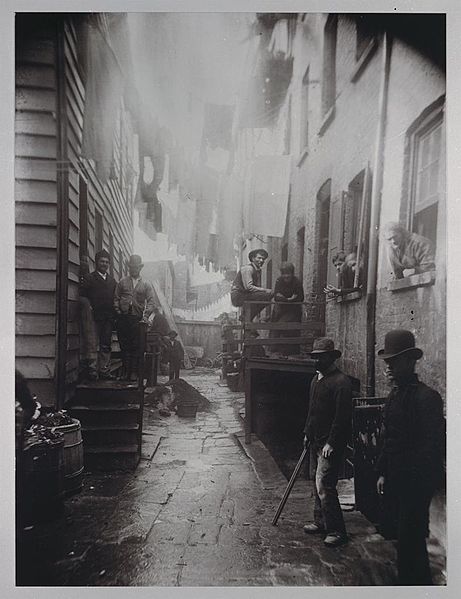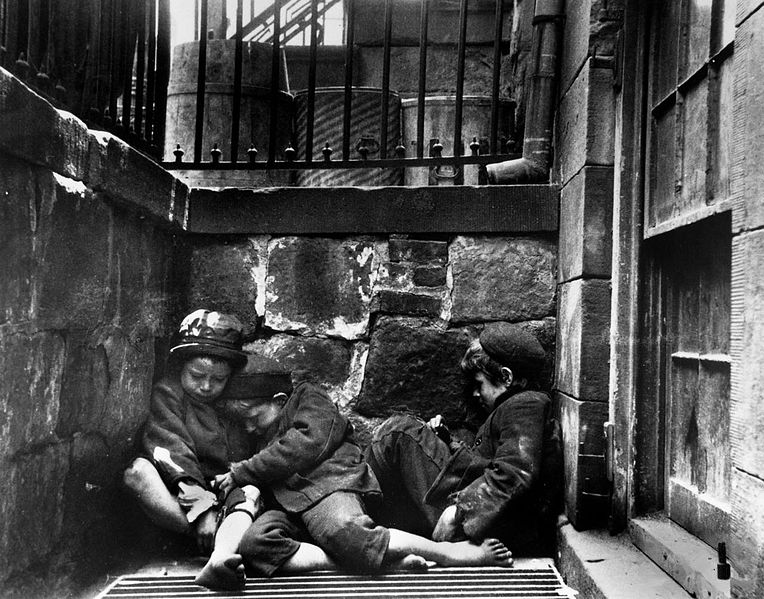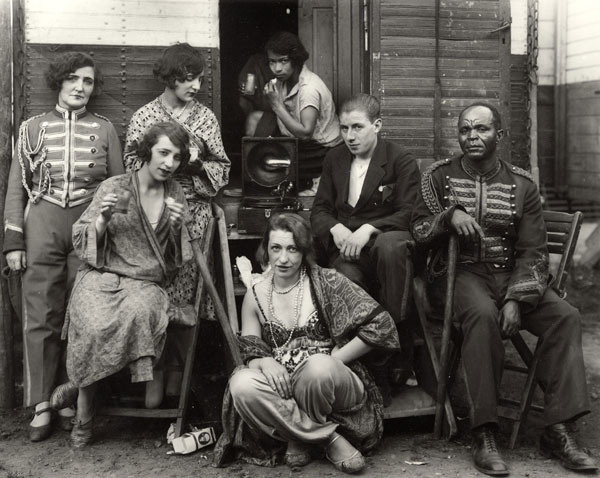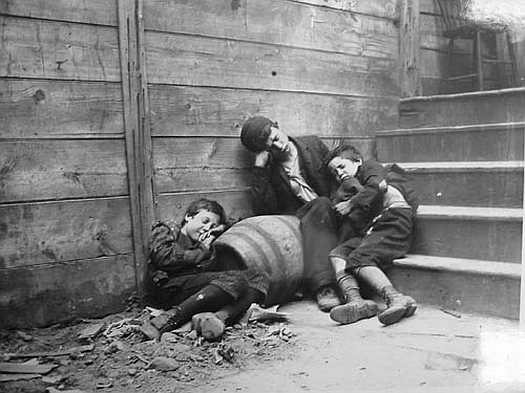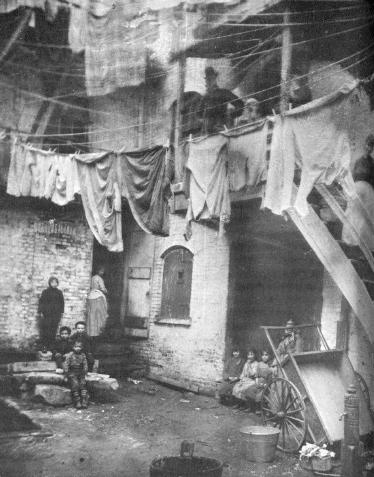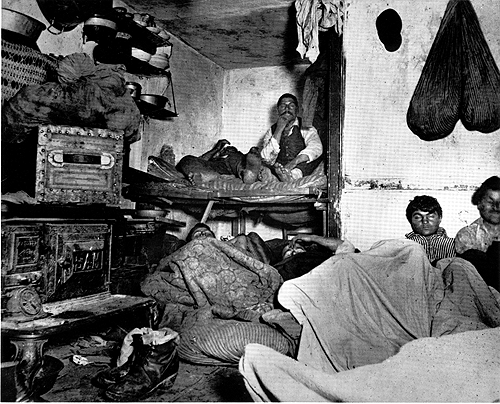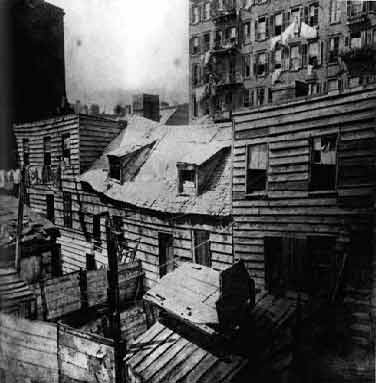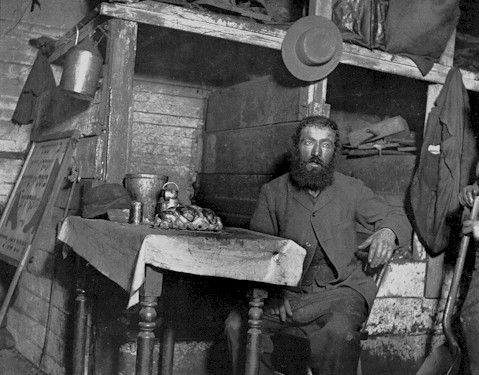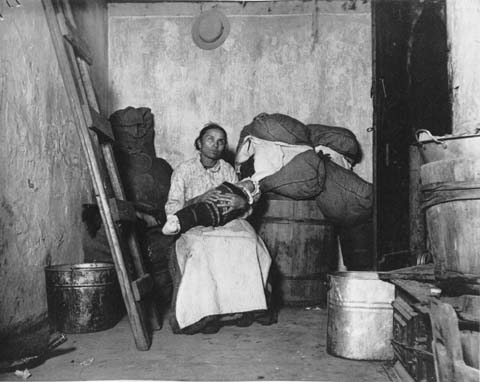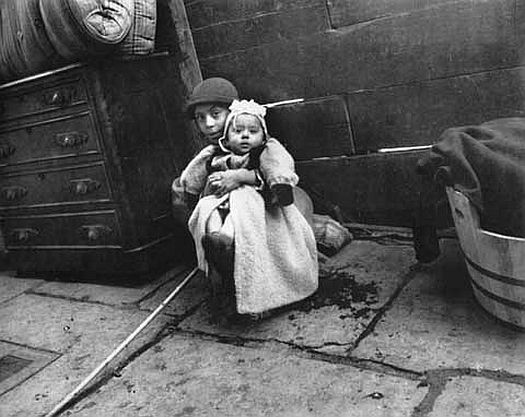<Back to Index>
- Social Reformer, Muckraker Journalist and Social Documentary Photographer Jacob August Riis, 1849
PAGE SPONSOR
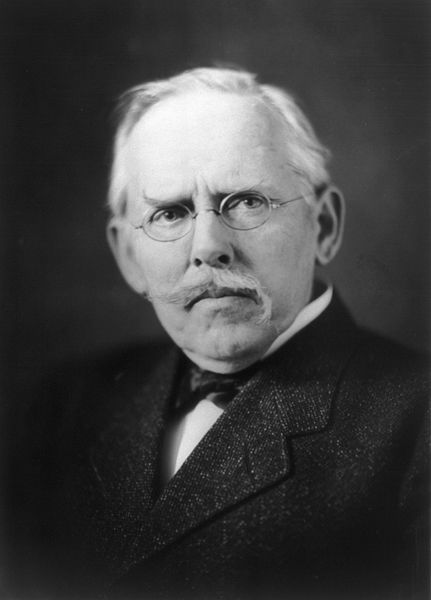
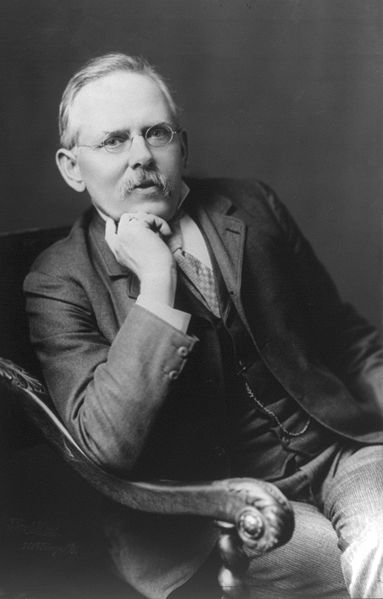
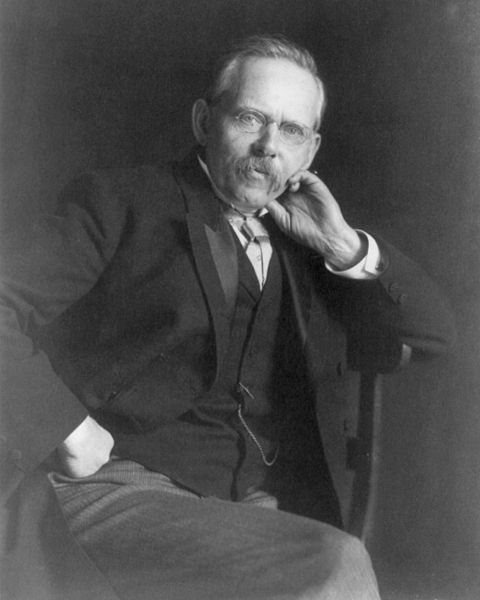
Jacob August Riis (May 3, 1849 – May 26, 1914) was a Danish American social reformer, "muckraking" journalist and social documentary photographer. He is known for using his photographic and journalistic talents to help the impoverished in New York City; those impoverished New Yorkers were the subject of most of his prolific writings and photography. He endorsed the implementation of "model tenements" in New York with the help of humanitarian Lawrence Veiller. Additionally, as one of the most famous proponents of the newly practicable casual photography, he is considered one of the fathers of photography due to his discovery of the use of flash in photography. While living in New York, Riis experienced poverty and became a police reporter writing about the quality of life in the slums. He attempted to alleviate the bad living conditions of poor people by exposing their traditionalism to middle class ridicule.
Jacob Riis was the third of the 15 children (one of whom, an orphaned niece, was fostered) of Niels Edward Riis, a schoolteacher and occasional writer for the local Ribe newspaper, and Carolina Riis (née Bendsine Lundholme), a homemaker. Among the 13, only Jacob, one sister and the foster sister survived into the twentieth century. Riis was influenced by his father, whose school Riis delighted in disrupting, and who persuaded him to read (and improve his English via) Charles Dickens's magazine All the Year Round and the novels of James Fenimore Cooper.
Jacob had a happy childhood, but experienced tragedy at the age of eleven when his brother Theodor, a year younger than he, drowned. He never forgot his mother's grief.
At age eleven or twelve years, he donated all the money he had and gave it to a poor Ribe family living in a squalid house, but on condition that they cleaned it. The tenants took the money and obliged; when he told his mother, she went to help.
Although his father had hoped that Jacob would have a literary career, Jacob wanted to be a carpenter. When he was 16 years old, he became fond of Elisabeth Gjortz, the 12 year old adopted daughter of the owner of the company for which he worked as an apprentice carpenter. The father disapproved of the boy's blundering attentions, and Riis was forced to complete his carpentry apprenticeship in Copenhagen. Riis returned to Ribe in 1868 at age 19. Discouraged by poor job availability in the region and by Gjortz's disfavor of his marriage proposal, Riis decided to emigrate to the United States.
Riis emigrated to America in 1870, when he was 21 years old, seeking employment as a carpenter. He first traveled in a small boat from Copenhagen to Glasgow, where on May 18 he boarded the steamer Iowa, traveling in steerage. He carried $40 donated by friends (he had paid $50 for the passage himself); a gold locket with a strand of Elisabeth's hair, presented by her mother; and letters of introduction to the Danish Consul, Mr. Goodall (later president of the American Bank Note Company), a friend of the family since his rescue from a shipwreck at Ribe.
Riis disembarked in New York on June 5, on that day spending half the $40 his friends had given him on a revolver for defense against human or animal predators.
The demographics of American urban areas became significantly more heterogeneous as many immigrants arrived, creating ethnic enclaves often more populous than many of the cities of their homelands. Large groups of migrants and immigrants, seeking prosperity in a more industrialized environment, came to urban areas during the years after the American Civil War. Twenty - four million people relocated to urban areas, causing their population to increase eightfold. "In the 1880s 334,000 people were crammed into a single square mile of the Lower East Side, making it the most densely populated place on earth. They were packed into filthy, disease ridden tenements, 10 or 15 to a room, and the well off knew nothing about them and cared less."
After five days, during which he used almost all his money, Riis found work as a carpenter at Brady's Bend Iron Works on the Allegheny River. After a few days of that he began mining for increased pay, but quickly resumed carpentry. Learning on July 19, 1870, that France had declared war on Germany, he expected that Denmark would join France to avenge the Prussian seizure of Schleswig, and determined to fight for France. He returned to New York, and, having pawned most of his possessions and without money, attempted to enlist at the French consulate, but was told that there was no plan to send a volunteer army from America. Pawning his revolver, he walked out of New York until he collapsed from exhaustion; on waking, he walked to Fordham College where a Catholic priest served him breakfast.
After a brief period of farm working and odd jobs at Mount Vernon, Riis returned to New York, where he read in the newspaper New York Sun that the newspaper was recruiting soldiers for the war. Riis rushed there to enlist, but the editor (whom he later realized was Charles Anderson Dana) claimed or affected ignorance but offered the famished Riis a dollar for breakfast; Riis indignantly refused. Riis was destitute, at one time sleeping on a tombstone and surviving on windfall apples. Still, he found work at a brickyard at Little Washington in New Jersey, and was there for six weeks until he heard that a group of volunteers was going to the war. Thereupon he left for New York.
On arrival, Riis found that the rumor was true but that he had arrived too late. He pleaded with the French consul, who expelled him. He made various other attempts to enlist, none successful. As autumn began, Riis was destitute, without a job. He survived on scavenged food and handouts from Delmonico's Restaurant and slept in public areas or in a foul smelling police lodging house. At one time Riis's only companion was a stray dog. One morning he awoke in a lodging house to find that his gold locket (with its strand of Elisabeth's hair) had been stolen. He complained to the sergeant, who, enraged, expelled him. Riis was devastated. The story became a favorite of Riis's. One of his personal victories, he later confessed, was not using his eventual fame to ruin the career of the offending officer. Disgusted, he left New York, buying a passage on a ferry with the silk handkerchief that was his last possession. By doing odd jobs and stowing away on freight trains, Riis eventually reached Philadelphia, where he appealed to the Danish Consul, Ferdinand Myhlertz, for help and was cared for two weeks by the Consul and his wife.
Myhlertz sent Riis, now dressed properly in a suit, to the home of an old classmate in Jamestown. Riis worked as a carpenter in Scandinavian communities in the western part of the state, also working a variety of other jobs. He achieved sufficient financial stability to find the time to experiment as a writer, in both Danish and English, although his attempt to get a job at a Buffalo, New York, newspaper was unsuccessful, and magazines rejected his submissions.
Riis was in much demand as a carpenter, a major reason being the low prices he charged. However, his employers exploited his efficiency and low prices, and Riis returned to New York City. He was most successful as a salesman, particularly of flatirons and fluting irons, becoming promoted to sales representative of them for Illinois. However, in Chicago he was cheated of both his money and his stock, and had to return to an earlier base in Pittsburgh. There he found that his subordinates he had left to sell in Pennsylvania had cheated him in the same manner. He again had little money, and while bedridden with a fever learned from a letter that Elisabeth, the former object of his affection, was engaged to a cavalry officer. Riis then returned to New York by selling flatirons along the way.
Riis noticed an advertisement by a Long Island newspaper for an editor, applied for and was appointed city editor. He quickly realized why the job had been available: the editor in chief was dishonest and indebted. Riis left in two weeks.
Again unemployed, Riis returned to the Five Points neighborhood. He was sitting outside the Cooper Union one day when the principal of the school where he had earlier learned telegraphy happened to notice him. He said that if Riis had nothing better to do, then the New York News Association was looking for a trainee. After one more night and a hurried wash in a horse trough, Riis went for an interview. Despite his disheveled appearance he was sent for a test assignment: to observe and write about a luncheon at the Astor House. Riis wrote this competently and got the job.
Riis was able to write about the rich and also life in impoverished immigrant communities. He did his job well and was able to become editor of a weekly newspaper, the News. However, this newspaper, the periodical of a political group, soon became bankrupt. Simultaneously, and unusually, Riis got a letter from home which related that both his older brothers, an aunt and Elisabeth Gjortz's fiançé had died. Riis wrote to Elisabeth to propose, and with $75 of his savings and promissory notes, he bought the News company.
Riis worked hard at his newspaper and soon paid his debts. Newly independent, he was able to target the politicians who had previously been his employers. Meanwhile, he received a provisional acceptance from Elisabeth, who asked him to come to Denmark for her, saying "We will strive together for all that is noble and good". Conveniently, the politicians offered to buy back the newspaper for five times the price Riis had paid; he was thus able to arrive in Denmark with a substantial amount of money.
After some months in Denmark, the newly married couple arrived in New York. Riis worked briefly as editor of a south Brooklyn newspaper, the Brooklyn News. To supplement his income, he used a "magic lantern" projector to advertise in Brooklyn, projecting either onto a sheet hung between two trees or onto a screen behind a window. The novelty was a success, and Riis and a friend relocated to upstate New York and Pennsylvania as itinerant advertisers. However, this enterprise ended when the pair became involved with an armed dispute between striking railroad workers and the police. Riis quickly returned to New York City.
A neighbor of Riis, who was the city editor of the New York Tribune, recommended Riis for a short term contract. Riis did well, and was offered the job of police reporter. He was based in a press office across from police headquarters on Mulberry Street. "Nicknamed 'Death's Thoroughfare'", Riis's biographer Alexander Alland writes, "It was here, where the street crooks its elbow at the Five Points, that the streets and numerous alleys radiated in all directions, forming the foul core of the New York slums."
During these stints as a police reporter, Riis worked the most
crime ridden and impoverished slums of the city. Through his own
experiences in the poorhouses, and witnessing the conditions of the poor
in the city slums, he decided to make a difference for them.
Working night shift duty in the immigrant communities of Manhattan's
Lower East Side, Riis developed a tersely melodramatic writing style and
he became one of the earliest reformist journalists.
Riis had for some time been wondering how to show the squalor of which he wrote more vividly than his words could express. He tried sketching, but was incompetent at this. Camera lenses of the 1880s were slow — necessarily, for depth of field despite their considerable focal length — as was the emulsion of photographic plates; photography thus did not seem to be of any use for reporting about conditions of life in dark interiors. In early 1887, however, Riis was startled to read that "a way had been discovered [. . .] to take pictures by flashlight. The darkest corner might be photographed that way." The German innovation, by Adolf Miethe and Johannes Gaedicke, was to mix magnesium with potassium chlorate and antimony sulfide for more stability; the powder was used in a pistol - like device that fired cartridges. This was the introduction of flash photography.
Recognizing the potential of the flash, Riis informed a friend, Dr John Nagle, chief of the Bureau of Vital Statistics in the City Health Department who was also a keen amateur photographer. Nagle found two more photographer friends, Henry Piffard and Richard Hoe Lawrence, and the four of them began to photograph the slums. Their first report was published in the New York newspaper The Sun on February 12, 1888; it was an unsigned article by Riis which described its author as "an energetic gentleman, who combines in his person, though not in practice, the two dignities of deacon in a Long Island church and a police reporter in New York". The "pictures of Gotham's crime and misery by night and day" are described as "a foundation for a lecture called 'The Other Half: How It Lives and Dies in New York.' to give at church and Sunday school exhibitions, and the like." The article was illustrated by twelve line drawings based on the photographs.
Riis and his photographers were among the first Americans to use flash photography. Pistol lamps were dangerous and looked threatening, and would soon be replaced by another method for which Riis lit magnesium powder on a frying pan. The process involved removing the lens cap, igniting the flash powder and replacing the lens cap; the time taken to ignite the flash powder sometimes allowed a visible image blurring created by the flash.
Riis's first team soon tired of the late hours, and Riis had to find other help. Both his assistants were lazy and one was dishonest, selling plates for which Riis had paid. Riis sued him in court successfully. Nagle suggested that Riis should become self sufficient, so in January 1888 Riis paid $25 for a 4×5 box camera, plateholders, a tripod and equipment for developing and printing. He took the equipment to the potter's field cemetery on Hart Island to practice, making two exposures. The result was seriously overexposed but successful.
For some three years Riis combined his own photographs with others commissioned of professionals, donations by amateurs and purchased lantern slides, all of which formed the basis for his photographic archive.
Because so much of the work was done at night, he was able to photograph the worst elements of the New York slums, the dark streets, tenement apartments and "stale - beer" dives, and documented the hardships faced by the poor and criminal, especially in the vicinity of notorious Mulberry Street.
Riis accumulated a supply of photographs and attempted to submit illustrated essays to magazines. But when an editor at Harper's New Monthly Magazine said that he liked the photographs but not the writing, and would find another writer, Riis was despondent about magazine publication and instead thought of speaking directly to the public.
This was not easy. The obvious venue would be a church, but several churches — including Riis's own — demurred, fearing either that the talks would offend the churchgoers' sensibilities or that they would offend rich and powerful landlords. However, Adolph Schauffler (of the City Mission Society) and Josiah Strong arranged to sponsor Riis's lecture at the Broadway Tabernacle church. Lacking money, Riis partnered with W.L. Craig, a Health Department clerk.
Riis and Craig's lectures, illustrated with lantern slides, made little money for the pair, but they both greatly increased the number of people exposed to what Riis had to say and also enabled him to meet people who had the power to effect change, notably Charles Henry Parkhurst and an editor of Scribner's Magazine, who invited him to submit an illustrated article.
An eighteen page article by Riis, How the Other Half Lives, appeared in the Christmas 1889 edition of Scribner's Magazine. It included nineteen of his photographs rendered as line drawings. Its publication brought an invitation to expand the material into an entire book.
Riis had already been thinking of writing a book, and began writing it during nights. (Days were for reporting for the New York Sun, evenings for public speaking.) How the Other Half Lives, subtitled "Studies Among the Tenements of New York", was published in 1890. The book reused the eighteen line drawings that had appeared in the Scribner's article and also seventeen reproductions using the halftone method, and thus "[representing] the first extensive use of halftone photographic reproductions in a book". (The magazine Sun and Shade had done the same during a year or so beginning 1888.)
How the Other Half Lives sold well and was much quoted. Reviews were generally good, although some reviewers criticized it for oversimplifying and exaggerating. Riis attributed the success to a popular interest in social amelioration stimulated by William Booth's In Darkest England and the Way Out, and also to Ward McAllister's Society as I Have Found It, a portrait of the moneyed class. The book encouraged imitations such as Darkness and Daylight; or, Lights and Shadows of New York Life (1892), which somehow appropriated Riis's own photographs.
Children of the Poor (1892) was a sequel in which Riis wrote of particular children that he had encountered.
Theodore Roosevelt introduced himself to Riis, offering to help his efforts somehow. Upon his 1895 appointment to the presidency of the Board of Commissioners of the New York City Police Department, Roosevelt asked Riis to show him nighttime police work. During their first tour, the pair found that nine out of ten patrolmen were missing. Riis wrote about this for the next day's newspaper, and for the rest of Roosevelt's term the force was more attentive.
Roosevelt closed the police managed lodging rooms in which Riis had suffered during his first years in New York. After reading the exposés, Roosevelt was so deeply affected by Riis's sense of justice that Roosevelt met and befriended Riis for life, later remarking about: "Jacob Riis, whom I am tempted to call the best American I ever knew, although he was already a young man when he came hither from Denmark".
After Roosevelt became President, he wrote a tribute to Riis that started:
| “ | Recently a man, well qualified to pass judgment, alluded to Mr. Jacob A. Riis as "the most useful citizen of New York". Those fellow citizens of Mr. Riis who best know his work will be most apt to agree with this statement. The countless evils which lurk in the dark corners of our civic institutions, which stalk abroad in the slums, and have their permanent abode in the crowded tenement houses, have met in Mr. Riis the most formidable opponent ever encountered by them in New York City. | ” |
For his part, Riis wrote a campaign biography of Roosevelt that praised him.
A particularly important effort by Riis was his exposure of the state of New York's water supply. His five column story "Some Things We Drink," in the 21 August 1891 edition of the New York Evening Sun, included six photographs (later lost). Riis wrote:
| “ | I took my camera and went up in the watershed photographing my evidence wherever I found it. Populous towns sewered directly into our drinking water. I went to the doctors and asked how many days a vigorous cholera bacillus may live and multiply in running water. About seven, said they. My case was made. | ” |
The story resulted in the purchase by New York City of areas around the New Croton Reservoir, and may well have saved New Yorkers from an epidemic of cholera.
Riis tried hard to have the slums around Five Points demolished and replaced with a park. His writings resulted in the Drexel Committee investigation of unsafe tenements; this resulted in the Small Park Act of 1887. Riis was not invited to the eventual opening of the park on 15 June 1897, but went all the same, together with Lincoln Steffens. In the last speech, the street cleaning commissioner credited Riis for the park and led the public in giving him three cheers of "Hooray, Jacob Riis!" Other parks also were created, and Riis was popularly credited with them as well.
Riis wrote his autobiography, The Making of an American, in 1901. His daughter, Clara C. Riis, married Dr. William Clarence Fiske. His son, John Riis (1882 – 1946), served in Gifford Pinchot’s new United States Forest Service from 1907 to 1913 as a ranger and forest supervisor on national forests in Utah, California and Oregon. He chronicled his time in the Forest Service in his 1937 book, Ranger Trails. Another son, Edward V. Riis, was appointed U.S. Director of Public Information in Copenhagen toward the end of World War I; he is known to have spoken publicly against antisemitism. In 1905, Jacob Riis's wife Elisabeth became ill and died. Riis remarried in 1907, and with his new wife, Mary Phillips, relocated to a farm in Barre, Massachusetts. Riis died at the farm on May 26, 1914. His second wife lived until 1967, continuing work on the farm, working on Wall Street and teaching classes at Columbia University.
Riis's concern for the poor and destitute often caused people to assume he disliked the rich. However, Riis showed no sign of discomfort among the affluent, often asking them for their support. Although seldom involved with party politics, Riis was sufficiently disgusted by the corruption of Tammany Hall to change from being an endorser of the Democratic Party to endorse the Republican Party. The period just before the Spanish – American War was difficult for Riis. He was approached by liberals who suspected that protests of alleged Spanish mistreatment of the Cubans was merely a ruse intended to provide a pretext for U.S. expansionism; perhaps in order not to offend his friend Roosevelt, Riis refused the offer of good payment to investigate this, and made nationalist statements.
Riis's sincerity for social reform has seldom been questioned, though critics have questioned his right to interfere with the lives and choices of others. His audience comprised middle class reformers, and critics say that he had no love for the traditional life styles of the people he portrayed. Stange (1989) argues that Riis "recoiled from workers and working class culture" and appealed primarily to the anxieties and fears of his middle class audience. Swienty (2008) says "Riis was quite impatient with most of his fellow immigrants; he was quick to judge and condemn those who failed to assimilate, and he did not refrain from expressing his contempt." Gurock (1981) says Riis was insensitive to the needs and fears of East European Jewish immigrants who flooded into New York at this time. Conservative economist Thomas Sowell (2001) argues that immigrants during Riis's time were typically willing to live in cramped, unpleasant circumstances as a deliberate short term strategy that allowed them to save more than half their earnings to help family members come to America, with every intention of relocating to more comfortable lodgings eventually. Many tenement renters physically resisted the well intentioned relocation efforts of reformers like Riis, states Sowell, because other lodgings were too costly to allow for the high rate of savings possible in the tenements. Moreover, according to Sowell, Riis's own personal experiences were the rule rather than the exception during his era: like most immigrants and low income persons, he lived in the tenements only temporarily before gradually earning more income and relocating to different lodgings.
Riis's depictions can be harsh. As portrayed in Riis's books, "The Jews are nervous and inquisitive, the Orientals are sinister, the Italians are unsanitary." In his autobiography, The Making of an American, Riis decided to allow his wife to add a chapter examining her own life. After letting her begin an honest and evocative biographical sketch over several pages titled "Elizabeth Tells Her Story," Riis decided his wife had had enough: "I cut the rest of it off, because I am the editor and want to begin again here myself, and what is the use of being an editor unless you can cut 'copy?' Also, it is not good for a woman to allow her to say too much."
